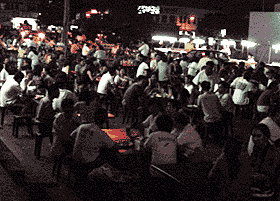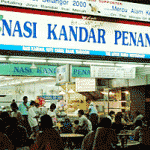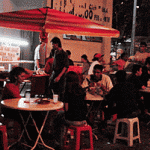The Mamak Phenomenon
You can't claim to have been to Malaysia if you have not visited a mamak stall. The Mamak Phenomenon is the hottest, and probably the longest lasting "cultural" scene in the country. To see and understand the true meaning of "melting pot", you've got to pop by at the mamak stalls when in the neighborhood.
What exactly is this mamak phenomenon, you ask? Well, it is something that I am proud of. It is something that is synonymous to Malaysians and also something that goes around rather cheaply!
To many Malaysians, Mamaks has got to be the best thing that ever happened to the country and its culture. It has given us a unique food and a different way of life. Before I go on, allow me to give you a little hindsight behind the "mamaks". Most Malaysians deemed mamaks as mere "food outlets" but in actual fact, there are more to it than that.
The Mamaks (meaning 'uncle') are actually people of Indian Muslims race that originated from the Madras Presidency. They first arrived in Malaysia during the 19th century, doing business in trading. These mamaks were popular with the royal rulers then. Since that time, they have planted their roots firmly on this land and slowly, they flourished. With time, the Mamaks have been accepted as part of the society and this was because of their similarities in terms of religion (Islam) and culture. Once settled here, what do you expect the men would do? Yes, marry the local Malay women and deepened their roots. These intermarriages have changed the appearances of the Malay folks and this is very obvious in states like Penang and Kuala Lumpur. Quite a number of these Mamaks still have families back in Madras but by now, this race have settled and blended in very well with the Malaysian society. In fact, they are as ethnic as any Malaysians could be. Easily recognized by their white shirts, white sarongs and white head cap, the Mamaks have branched out into other profession like moneychangers or licensed moneylenders. Some even own bread companies or bookstores.
Along with their cultural background, the Mamaks also brought and introduced to all Malaysians their culinary expertise. Food like murtabak, roti canai, mee goreng, and nasi kandar are some of the mouth-watering "mamak" meals indulged by many Malaysians on a daily basis. Then, there is also the famous teh tarik, a drink you must try! The list also goes on to cover mee rebus, mee goreng and other variations that the Malaysians have grown to love.
Despite the range of professions that these people have gone into, there is one that leaves the deepest imprint to the Malaysian night scene (especially the night scene). So, if you are in Malaysia one day and you hear someone saying, "Let's go to the mamak!" - well, it does not mean you are invited to an Indian Muslim fella's home. This well-used phrase merely means you are invited to an al-fresco food stall for a bout of great food and friendly conversation. The Mamaks have made the "mamak stalls" a great activity for many Malaysians. What is a mamak stall, anyway?
These mamak stalls are everywhere but do take note. You may not be able to find them in certain parts of the country. The influx of mamak stalls is mostly concentrated in Kuala Lumpur and other bigger states like Penang and Johor. And it is at these places that you will find them, braving the sun and rain for hours on end. Some stalls are opened 24 hours a day, 7 days a week, 365 days per year. Some are only opened at night; any time from 7 pm to the wee hours of the morning. You can find these stalls in a tiny corner by the road or under makeshift tents. In fact, any spare space not filled in by a developer will be wittily taken over by a mamak.
The mamak stalls phenomenon is a very active trend nowadays. Instead of hanging out at a pub or watering hole, the general Malaysians prefer to pay the stalls a visit in the evenings. At the stalls, you will find foldable tables and chairs placed along the street; some even take over parking space along the stretch. The bigger mamak stalls are able to fill up the whole street with hundreds of people at any one time. This is the place where you can drop by for a drink of the delicious teh tarik or a bite of the staple roti canai. Aside from the roti canai, there are also other forms of roti. A roti looks like a pancake "clapped" together to form a soft purse-like crepe. The Mamaks preparing the roti will have to knead the dough first. The dough is then formed into small balls and is kept overnight. When ready to make the roti canai, some ghee is spread on the balls of dough and flattened. The Mamak will then flip the flattened dough to get a thin texture. Later it is folded together and fried on an iron griddle. The roti canai is best served with dhal or curry. There are other variations to it. By adding an egg before frying, you will get roti telur (telur means egg). If added with onions, you will therefore get a roti bawang (bawang means onion). There are all sorts of ingredients you can add to a roti as it is a truly versatile dish. You can even add sardine if you want, thus making roti sardine.
Aside from the roti, there have been many new additions to the general mamak food. Try also the mee goreng (fried noodles the mamak way), tandoori chicken, maggi mee goreng or soup (another form of fried noodles or soup-based), nasi kandar (rice with side dishes), murtabak (like minced beef packed in a pancake, a little like the roti canai) and lots more. And of course, you must wash it all down with the famous teh tarik. Teh tarik literally means "pull tea" where the drink is prepared by the mamak using out-stretched hands, pouring the piping hot tea from a mug into a waiting glass. The higher the pull, the thicker the froth. And the thicker the froth, the yummier it is! You must also try other favorite drinks such as teh o ais limau (the mamak version of the ice lemon tea, except that this uses lime instead of lemon), Milo Ais (iced Milo) and sirap limau (syrup with lime).
The "hanging out at the mamak stalls" culture has in turn bred many other stalls that serve their food in similar fashion. Nowadays, you can easily find food at any time of the day served al-fresco style. If you look closely, you could perhaps find a Malay or a Chinese person manning the stalls instead of a Mamak. Of course, with the different ethnic groups, you will obtain different foods at different stalls as well. I mean, don't expect to see a Chinese guy flipping rot canais for you (well, you might but only on very rare occasions) or a Malay guy making you mee goreng the mamak way.
However, the best part about these mamak stalls is the ambience. Food is cheap and delicious while the ambience is light and casual. You don't even need to dress up for it. Just walk in with your tees, shorts and sandals, and prepare for a night of great food, good conversation and lots of teh tarik. Given their ubiquity, it is hard to imagine life without the mamak stalls. Over the years, it has grown from a mere food joint to a common meeting ground for friends. This is where you can share the day's goings-on, catch up on the latest gossips or just chat. And this is one form for cheap entertainment for all Malaysians!
Do check out Mamak.com for a listing of mamak stalls and other al-fresco eateries. There are pictures as well.
 ThingsAsian
ThingsAsian
















